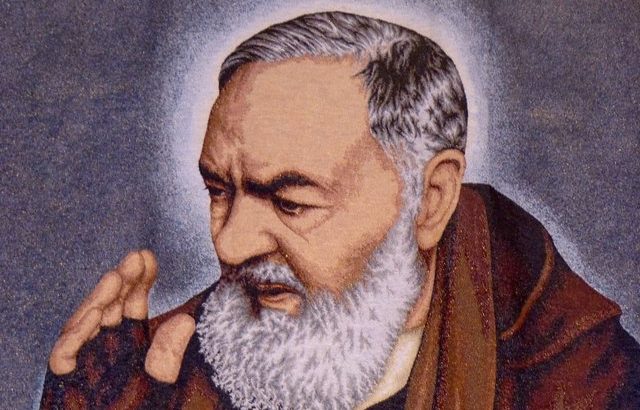St Pio represents the quiet but courageous mission of Christians across the world, writes Colm Fitzpatrick
Oftentimes, religious movies tend to focus on the incredible or miraculous events of an occasion or person, resulting in piety overkill – but one Catholic priest has decided to present the life of a renowned saint in a much quieter and more touching way.
Hoping to offer “a breath of fresh air” to our understanding of St Padre Pio of Pietreclina, the new movie We’ll Rise at Dawn: The Strength of Friendship gives a nuanced take on what we can learn from the Italian Capuchin friar to a modern audience who may not have even heard his name uttered before.
The 96-minute movie which has already screened across the globe is non-biographical, and explores the story of two young boys, Luca and Sebastian, from San Giovanni Rotondo who seek out to learn more about the saint of Gargano, by conducting research among the people in their town who knew him.
Highlight
Speaking in the newly-located Irish Office for St Pio at Dublin’s Capuchin friary on Church Street, director Fr Jean-Marie Benjamin told The Irish Catholic that the movie aims to highlight “the strength of friendship in the life of young people” which can be “pure, sincere and very strong”, and also offer an insight into the positive everyday lives of Italian people.
“I would like to show a different sort of Italy, not always the criminality, the mafia, and everything, but the normal people – they are the majority,” he explains.
Indeed, it seems that the French priest is well-qualified to explore the shades and beauty of Italy given that he has lived in the country since 1974 and has a wealth of experience in movie-making. Ordained in 1991, Fr Benjamin wrote, produced and directed the first fictional film dedicated to the life and work of St Pio, Padre Pio: The Night of the Prophet, which from 1999 until today has been regularly broadcast on the EWTN Network in the US.
On top of this, he is a composer and conductor, and plays the guitar, piano and electric keyboard. From 1966 until today, he has recorded 28 albums – works of classical music, film soundtracks and popular music. He is also the author of the Official Anthem of UNICEF (‘Ode to the Child’), created in Rome in April 1984. Notably, all of the music in the film is played by him, highlighting his personal dedication to the movie.
While the temptation existed to mention Padre Pio in the title of the film, Fr Benjamin made a conscious decision to exclude his name, believing that it would attract more attention from a lay audience who were unaware of the saint’s existence.
“I made the film for a lay approach, because if some people see that it’s a religious film, they won’t go to the cinema to see that. Most people in France for example,” he says, adding that if the audience encounters a more familiar image of two families in the south of Italy, they can slowly discover the figure of the saint.
Of course, Fr Benjamin’s inspiration for the movie wouldn’t have occurred had he not met St Pio in San Giovanni Rotondo in 1968, just prior to his death. This is the location where the then-Francesco Pio was assigned to in 1916, to work with the seven-strong community of Our Lady of Grace, and where he would remain. The Italian area was also where the news of Padre Pio receiving stigmata – wounds corresponding to those Christ suffered on the Cross – began and subsequently spread across the world.
Despite the movie being fictional, three of the characters the two boys interview in their efforts to write a book about the saint, actually knew and spoke to Padre Pio. They were real witnesses of his miracles, charisms, extraordinary gifts, his sufferings and configuration to the Cross of Christ. As a result, the audience are faced with the new generation that discovers Padre Pio, which is confronted with the one that has already known him. Between one interview and another, the two exchange their impressions, with arguments, amusing episodes and boyish banter, alternating with some very moving moments.
“During the film we see the people smile and some people cry because there are emotional moments. It’s very emotional and very sensory,” Fr Benjamin says, adding that one of the child actors actually cried during the shoot because of how significant it felt to be present in the special movie.
“The testimony of Padre Pio is only six or seven minutes in the film, but it’s enough because it’s not a documentary. I can’t explain the end of the film because the end of the film is fantastic, it’s a fiction but the film is a crescendo. And the music is fantastic because it’s my music!” he jokes.
The filming of the movie took place last year to mark the 50th anniversary death of St Pio and the 100th anniversary of the stigmata; but for Fr Benjamin, the movie doesn’t just represent a different approach to presenting this saint, but also a shift in how the media popularly portray religious life.
“But you know, the problem is that, we talk about a lot of scandal in the Church now. It’s a terrible situation you know. I prefer to talk about the saints. In 2,000 years, the Church has had hundreds and hundreds of saints.
“The media don’t talk about Mother Teresa of Calcutta or the friars or the Capuchins in Amazonia or Brazil, who help the people, or the priests who are killed in the Middle East by Daesh, and I prefer to talk about this aspect of the Church,” Fr Benjamin says.
He stresses that it’s easy to forget about those Christians who are quietly but courageously working to create a better world, and that the new movie attempts to highlight this often-overlooked missionary work.
“The people are positive, not only the saints, but the normal people, we have thousands and thousands of priests and sisters who work in the world doing fantastic work. They risk their lives. I prefer to present this side of the Church, to focus on the positive because the people need to have something positive, not only the bad news about some terrible guys who made a very big criminal mistake, at this moment in the Church. Yes, it’s a sad reality, but I prefer to present the other face, the face of the positive and what the Church and people can do.”
*****
Screenings of the film have taken place in various countries and festivals across the world, and last month the touching picture came to Ireland for the first time. Marian Pilgrimages, which is the official agent for the Irish Office for St Pio, were responsible for the two Irish screenings in Tralee and Dublin.
With well over 200 people turning up in total, Marian Pilgrimages’ Shrines of Italy Manager Amanda Devine, said that the enthusiasm for the movie shows that “there most definitely is still a religious appetite” in Ireland, adding that the film can inspire and move those of all ages.
“The reality was that the majority of those in attendance were in the over-65 age bracket. It was however encouraging to see some families arrive with young children. The aim of this film is to reach out also to the younger generation, teach them about Padre Pio, and through the story of Padre Pio the power of faith and the strength of friendship.”
She adds that through this faith, tangible and positive differences can be made in the lives of people who are in desperately in need of God, pointing to the private hospital St Pio built in the 1950’s, which today is known for its modern technologies and efficiency.
The friar called the hospital the Casa Sollievo della Sofferenza, or ‘Home for the Relief of the Suffering’, because, as he said later, this work was inspired and created to be a “spiritual demonstration” of God’s love through a call for charity.
”When he decided to build a hospital in San Giovanni Rotondo he said he wanted to build a ‘cathedral of science and faith’ – a place where prayer and science could unite to relieve the pain of the suffering. This is very much evident today in the hospital with the spiritual needs of the sick provided by the nuns from the Apostles of the Sacred Heart of Jesus Sisters, whom Padre Pio chose to serve the sick, along with the support of the Capuchin community,” Ms Devine explains.
Taking around three years to complete, Fr Benjamin says that he is “happy” about the reactions the movie has received, and hopes that it not only touches devotees of the saint, but also makes an “impression” on atheists or those who don’t attend Church.
While creating the movie was a stressful ordeal, he adds that the real worry on his mind now is the dwindling number of people going to the cinema – but despite this dearth – he has faith that the saint of Gargano will guide the film in the right direction.
“Netflix, Amazon Prime, Sky on demand, and the people don’t go to cinema. It’s a difficult situation. But with help of Padre Pio, we can do it!”


 Colm Fitzpatrick
Colm Fitzpatrick
